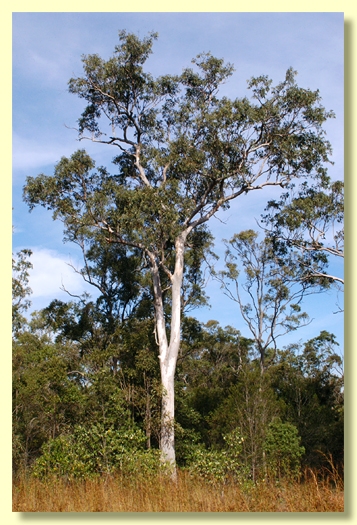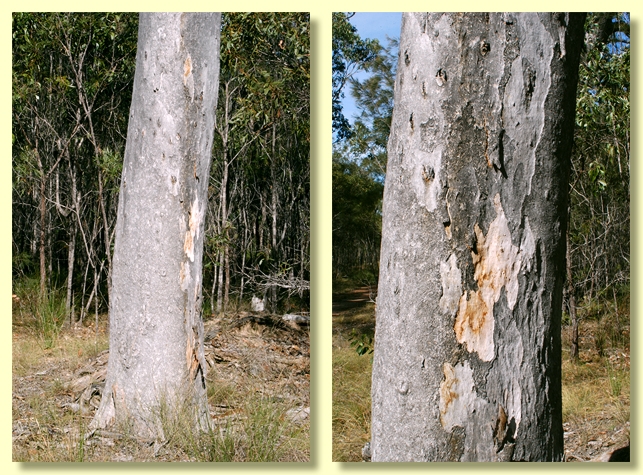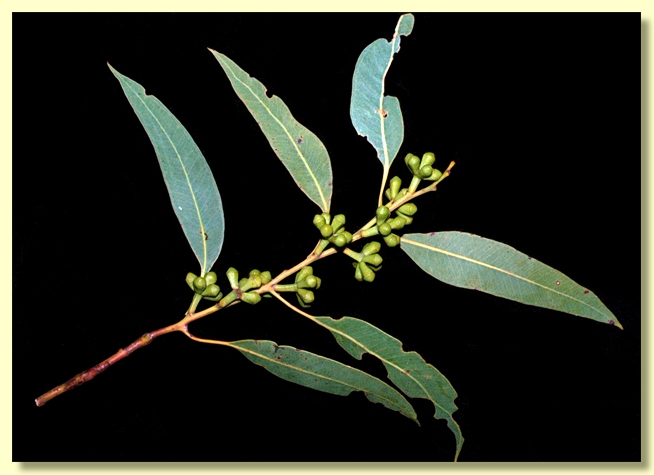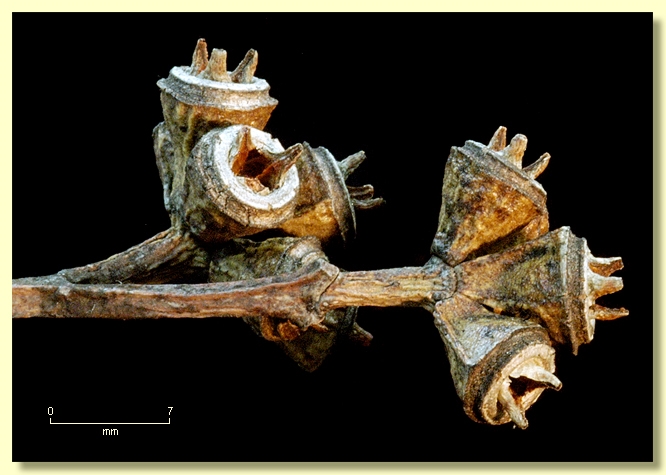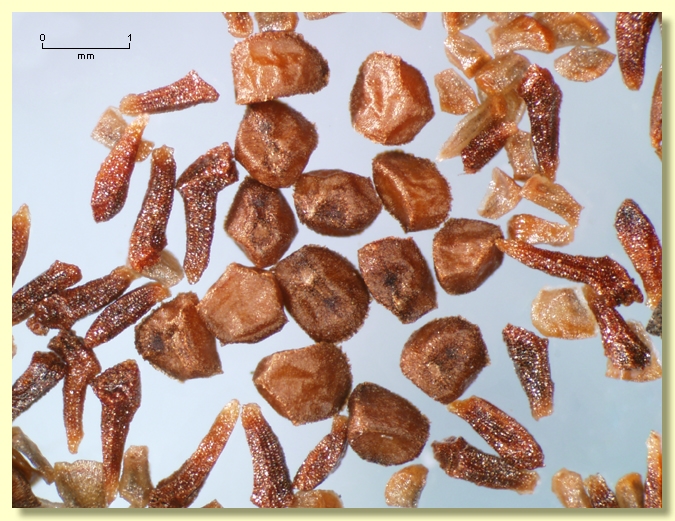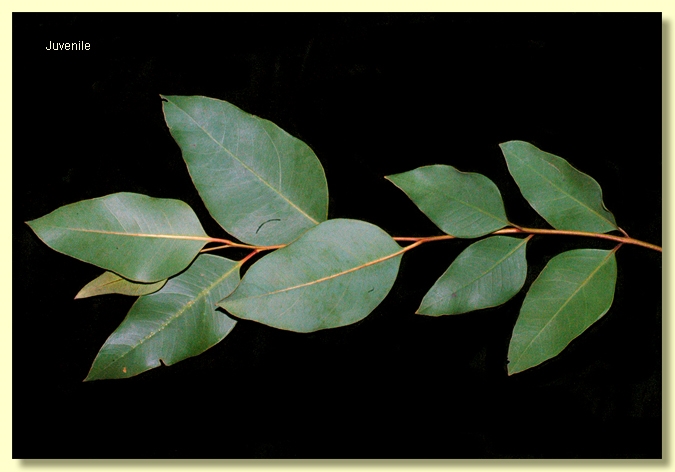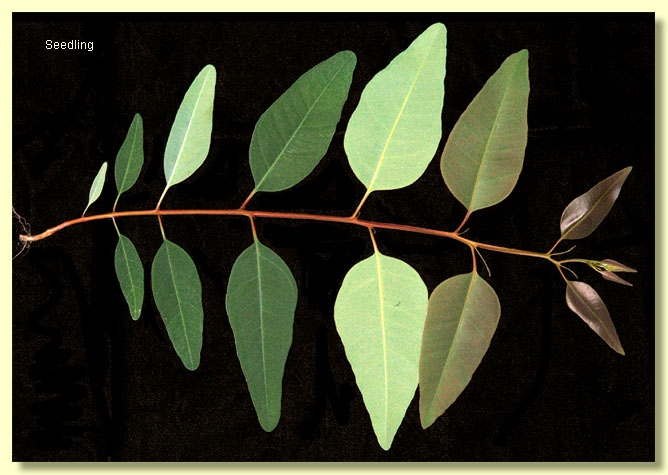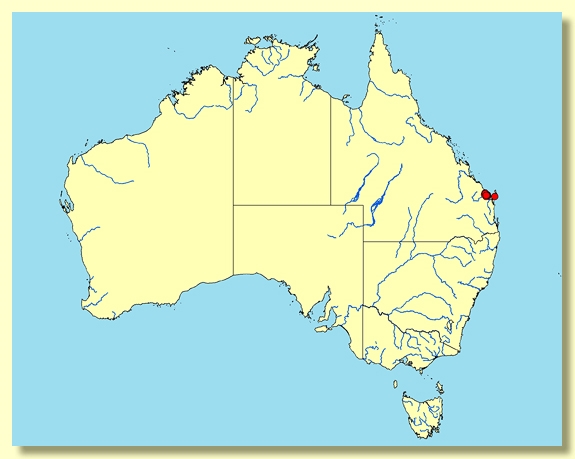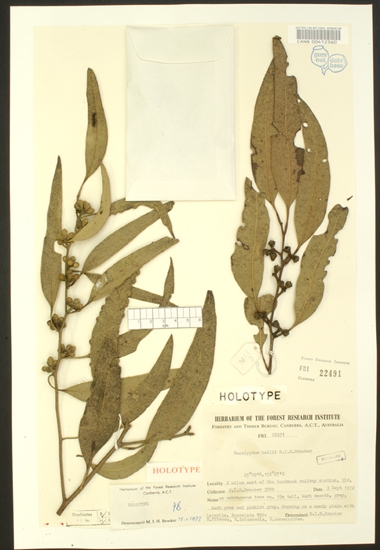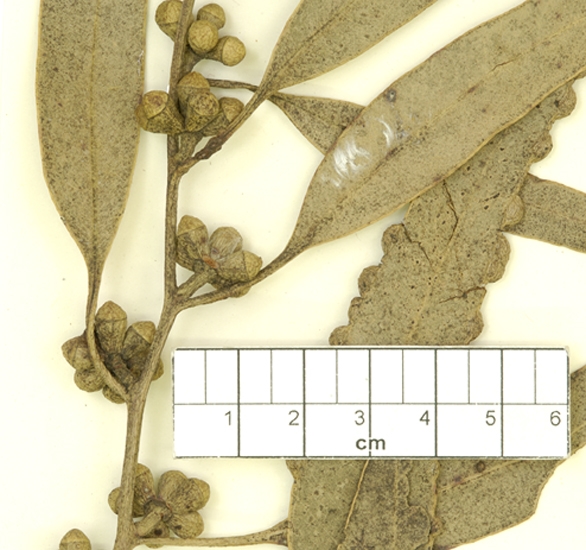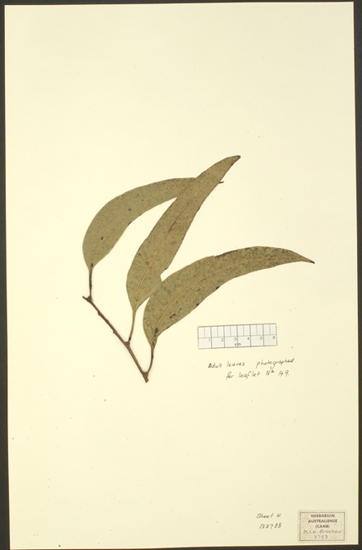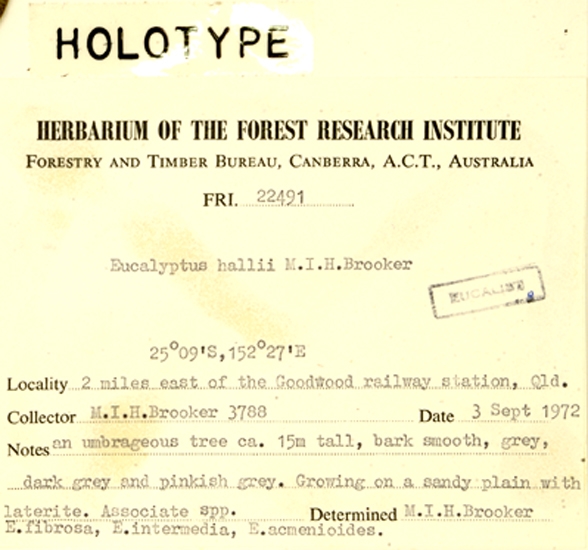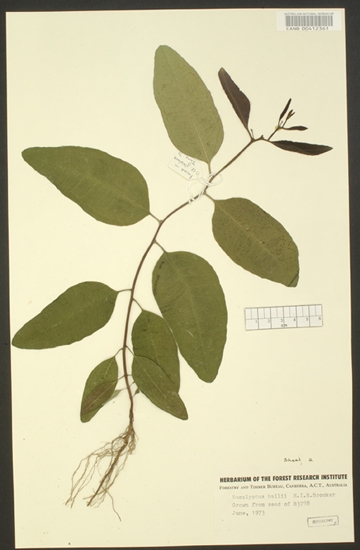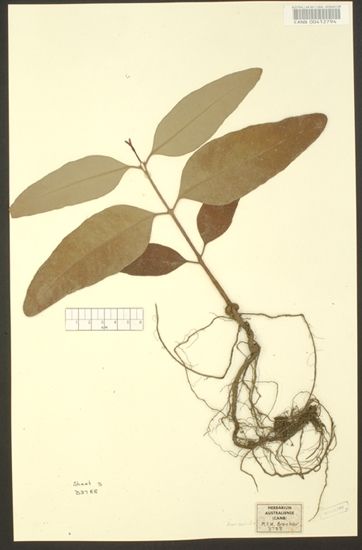Euclid - Online edition
Eucalyptus hallii
Eucalyptus | Symphyomyrtus | Exsertaria | Connexentes
Eucalyptus hallii Brooker, Austral. Forest Res. 7: 11 (1975).
T: Queensland: 2 miles (c. 3 km) E of Goodwood railway station on Woodgate road, 25° 09' S, 152° 27' E, 3 September 1972, M.I.H.Brooker 3788; holo: CANB; iso: BRI, NSW, NT, PERTH.
Tree to c. 20 m tall. Forming a lignotuber.
Bark smooth, new bark pale orange to pale pink, maturing to white and grey, becoming granular with age,.
Juvenile growth (coppice or field seedlings to 50 cm): stems square to round in cross-section, not glaucous; juvenile leaves always petiolate, sub-opposite to alternate, ovate to broadly lanceolate, 12–22 cm long, 4.5–9 cm wide, base tapering to rounded, green.
Adult leaves alternate, petioles 1.2–3 cm long; blade lanceolate to broadly lanceolate to falcate, (9)12–17(21) cm long, (1.5)2–3.5(4.5) cm wide, base tapering to petiole, margin entire, apex pointed, concolorous, dull to slightly glossy green, side-veins at a wider angle than 45° to the midrib, reticulation dense, intramarginal vein present, oil glands mostly intersectional, rarely island.
Inflorescence axillary unbranched, peduncles 0.3–1 cm long, buds 7 per umbel, sessile to shortly pedicellate (pedicels 0–0.3 cm long). Mature buds obovoid, 0.6–0.9 cm long, 0.4–0.5 cm wide, scar present, operculum rounded to broadly conical (0.2–0.4 cm long), hypanthium sometimes with two longitudinal ridges, stamens regularly inflexed, anthers oblong, versatile, dorsifixed, dehiscing by longitudinal slits, style usually long and straight, sometimes much shorter and not touching the top of the operculum, stigma blunt, locules (3)4, the placentae each with 6 or more vertical rows of ovules. Flowers white.
Fruit sessile to shortly pedicellate (pedicels 0–0.2 cm long), obconical, non-glaucous, 0.4–0.6 cm long, 0.6–0.8 cm wide, sometimes with two longitudinal ribs, disc raised and annular to convex, valves (3)4, exserted.
Seeds brown, 0.7–1.1 mm long, flattened ovoid to ± pyramidal, dorsal surface shallowly reticulate, edge of seed with small sharp teeth, hilum ventral.
Cultivated seedlings (measured at ca node 10): cotyledons bilobed to oblong, stem square in cross-section; leaves opposite for 4 to 10 nodes, then alternate, always petiolate, ovate to broadly lanceolate, 7–14 cm long, 2.5–6 cm wide, base rounded to tapering to the petiole, dull green.
Flowering time unknown.
A small to medium-sized tree from the coastal, poorly drained flats of the Bunderberg – Childers – Maryborough – Fraser Island district of south-east Queensland. Characterised by its smooth, grey to white, often granular bark, its lanceolate to broadly lanceolate adult leaves, its sessile to shortly pedicellate obovoid buds and its obconical fruit with prominently exserted valves.
Eucalyptus hallii has been placed in the series Connexentes, because of its granular smooth bark, the adult leaves with dense reticulation, the inflexed stamens and the flattened seeds with a more or less ventral hilum. There is only one other species in the series Connexentes, E. broviniensis. E. hallii differs marginally from E. broviniensis by having slightly narrower adult leaves, shorter umbel peduncles and smaller fruit but some overlap in the dimensions does occur. (E. hallii with adult leaves 2–3.5 cm wide, umbel peduncles 0.3–1 cm long and fruit 0.6–0.8 cm wide; E. broviniensis with adult leaves 2.5–4.5 cm wide, umbel peduncles 0.8–2.2 cm long and fruit 0.7–1 cm wide.)
Eucalyptus hallii is also very closely related to the species placed in the subseries Applanatae, particularly E. alba var. australasica. E. alba var. australasica, from the Top End of the Northern Territory and the Kimberley region of Western Australia, differs only marginally from E. hallii by having distinctly pedicellate buds and fruit and by its hemispherical to funnel-shaped fruit with the valves not as prominently exserted. (The buds and fruit of E. hallii are sessile to shortly pedicellate and the fruit is always funnel-shaped with strongly exserted valves.) The bark of E. hallii is sometimes granular, like grey gum bark, while the bark of E. alba var. australasica is never granular and often powdery. E. platyphylla, another Queensland species from this same subseries, can be separated by having much wider, ovate to orbicular to deltoid adult leaves (usually wider than 4.5 cm in E. platyphylla but lanceolate to broadly lanceolate and less than 4.5 cm in E. hallii ).
Eucalyptus tereticornis and E. bancroftii, two red gums with similar smooth bark to E. hallii and growing within the same area of occurrence, can be easily separated by having long conical to horn-shaped opercula (always short, blunt and rounded in E. hallii).
Because of its granular bark like that of grey gums, E. hallii may be confused with some of the true grey gums of that area, i.e. E. propinqua, E. longirostrata and E. major. They can be easily distinguished by all having discolorous adult leaves (always concolorous in E. hallii).
Eucalyptus hallii is listed as "Vulnerable" under the Australian Government Environment Protection and Biodiversity Conservation Act 1999 (EPBC Act). Further information may be found at this web address:
http://www.environment.gov.au/cgi-bin/sprat/public/sprat.pl
Eucalyptus hallii: after Norman Hall (1906–2005). Norman Hall was one of the senior authors of Forest Trees of Australia (1957) and was also responsible for the revision and enlargement of the third edition (1970). From 1970 –1975 he was involved in the field collecting, the photographic illustration and the writing of nearly 200 Forest Tree Series leaflets, each one dedicated to one species of eucalypt. Most of this work was done in collaboration with Ian Brooker, who named this species in his honour.

